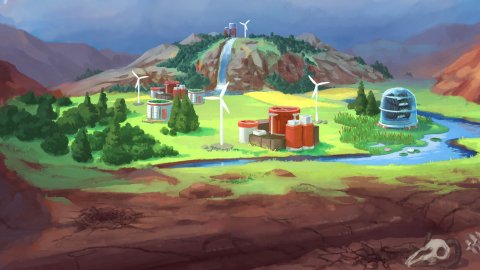Terra Nil, the tried and tested of a management system in which we have to rebuild the world

Terra Nil
Free Lives is a decidedly over the top development studio capable of offering very different titles, but always characterized by a strong anarchic and rebellious spirit. His most famous game is certainly the pixel art platformer Broforce, which was followed by a gladiator simulator for VR viewers called Gorn and a strange adventure party game with the protagonists of the male reproductive organs, called Genital Jousting.To continue the tradition of never launching a game that is the same as the previous one, now it is the turn of a management software on the contrary, as the developers themselves like to call it, in which the player has to do nothing but give life to a planet destroyed by his ancestors, restoring the various ecosystems and leaving after having succeeded in the enterprise, but recycling all the structures built for the occasion.
Intrigued by the premise, we tried Terra Nil, thanks to a demo that allowed us to discover a very interesting title.
The demo
In Terra Nil the world is a barren, lifeless expanse The demo, available to everyone on the Terra Nil Steam page, allows you to experience a single scenario. As already mentioned, the goal is not to colonize, but to revive barren and inhospitable lands, destroyed by human intervention. The first thing to do is to bring electricity by building wind turbines on rocks. The various machines available can be connected to these, all of which can be selected from a quick selection menu, located in the lower part of the screen. The preliminary actions to be carried out are fairly straightforward: the soil must be prepared, in order to make it fertile, then the first vegetation must be grown. Where present, it is also possible to recreate rivers in gullies. The latter will have a very important function in the final phase of the mission, because they will allow the recovery of the materials of the structures to be recycled.However, once most of the land is greened (there is a specific goal to be achieved), we can move on to the next phase, which consists in diversifying the biomes. For example, you can create controlled fires to have the right humus to build forests, or you can concentrate the humidity to have more fertile areas.
If necessary, you can also create new rocks, on which to place other wind turbines, or dig new channels, to create new rivers. When all the goals set by the scenario have been achieved, it is also time to leave. The recycling phase then begins, which is the one that subverts many of the canons of the genre. The territory no longer needs our presence, so all that remains is to use recycling centers to destroy existing buildings and use the materials to build an airship with which to move to the next territory.
In fact Terra Nil asks us to do the exact opposite of what is usually done in similar titles: instead of standing there and gazing at how much we have grown and become powerful, we must eclipse ourselves and let nature take the its course. If we want it is an interesting point of view, at least original, on the genre, which places us in a critical position on what are usually the objectives we pursue, as well as on the model of society usually represented by these games, which magnifies the "infinite growth "advocated by capitalism without showing its limits and concrete risks.
To recreate certain biomes, you must first create a controlled fire. draw conclusions, even if only on the vision of the world that moves the game. Overall we liked it, but it remains to be verified whether certain mechanics will perform well in a wider context or if they will become bottlenecks for the experience, making it very repetitive.
From a technical point of view we are at facing a very simple title: the game world is divided into boxes that change appearance according to the recreated biome. When the vegetation becomes predominant, among the plants also small animals appear, such as bears, deer, frogs, birds and so on, which make the environment very lively. While the graphics engine doesn't do anything amazing, seeing the restored territory is quite impressive. Do not expect anything to put a strain on graphics cards, however, also because this is definitely not the goal of Terra Nil.
The Terra Nil demo is too short for us to make any precise judgments. Let's say that the premises are very interesting, but it will be necessary to see if they will hold up in a complete title, given that the risk of repetition is around the corner. In the final version we expect to find more biomes to regenerate, more structures to build and recycle, and more difficulties in achieving the objectives. We'll see.